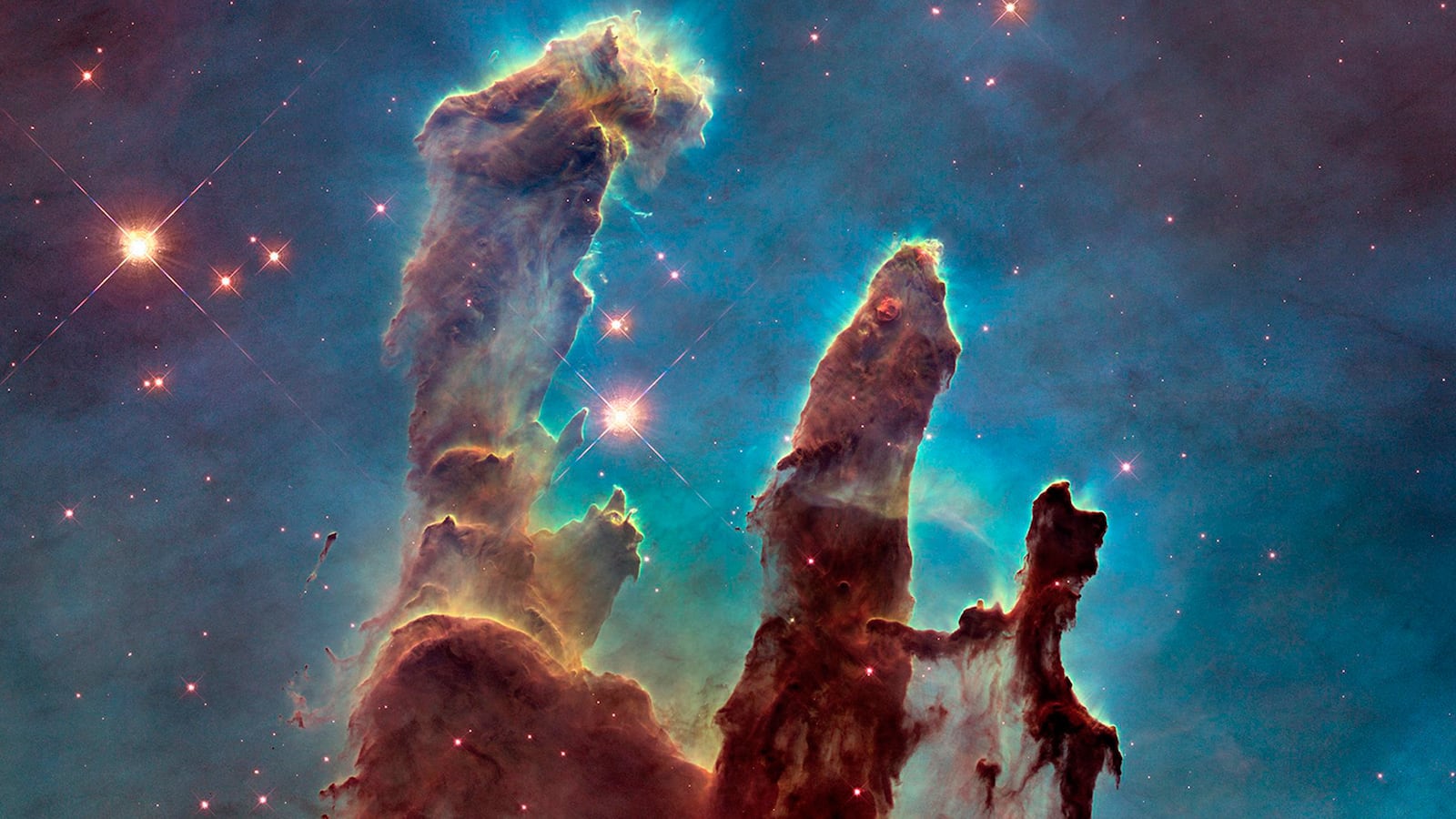
The Hubble telescope snapped this photo of the iconic Eagle Nebula's "Pillars of Creation." By comparing 1995 and 2014 pictures, astronomers noticed a lengthening of a narrow jet-like feature that may have been ejected from a newly forming star. Over the intervening 19 years, this jet has stretched farther into space, across an additional 60 billion miles, at an estimated speed of about 450,000 miles per hour, according to a NASA news release.
NASA/Reuters
The Whirlpool Galaxy, a classic spiral galaxy, is pictured in this Hubble photo. At only 30 million light years distant and fully 60 thousand light years across, M51, also known as NGC 5194, is one of the brightest and most picturesque galaxies on the sky. This image is a digital combination of a ground-based image from the 0.9-meter telescope at Kitt Peak National Observatory and a space-based image from the Hubble, highlighting sharp features normally too red to be seen.

The Crab nebula is arguably the single most interesting object, as well as one of the most studied, in all of astronomy. The image is the largest image ever taken with Hubble's WFPC2 workhorse camera. The Crab Nebula is one of the most intricately structured and highly dynamic objects ever observed. The new Hubble image of the Crab was assembled from 24 individual exposures taken with the NASA/ESA Hubble Space Telescope and is the highest resolution image of the entire Crab Nebula ever made.

The Hubble captures U Camelopardalis—or U Cam, for short—a star nearing the end of its life in the constellation of Camelopardalis, near the North Celestial Pole. As it begins to run low on fuel, U Cam is becoming unstable. Every few thousand years, it coughs out a nearly spherical shell of gas as a layer of helium around its core begins to fuse. The shell of gas, which is both much larger and much fainter than its parent star, is visible in intricate detail in Hubble's portrait. While phenomena that occur at the ends of stars' lives are often quite irregular and unstable, the shell of gas expelled from U Cam is almost perfectly spherical.
NASA/Reuters
An expanding shell of debris called SNR 0519-69.0 is left behind after a massive star exploded in the Large Magellanic Cloud, a satellite galaxy to the Milky Way. Multimillion degree gas is seen in X-rays in blue. The outer edge of the explosion, which you can see in red, and stars in the field of view are seen in visible light from the Hubble.

The spiral galaxy NGC 5793 featured in this image is more than 150 million light-years away in the constellation of Libra. These galaxies have incredibly luminous centers that are thought to be caused by hungry supermassive black holes.

NGC 2174, also known as the Monkey Head Nebula, is a churning region of star birth that is located about 6400 light-years away in the constellation of Orion.

This image shows cosmic clouds and stellar winds featuring LL Orionis, interacting with the Orion Nebula flow. Adrift in Orion's stellar nursery and still in its formative years, variable star LL Orionis produces a wind more energetic than the wind from our own middle-aged Sun. This picture is part of a large mosaic view of the complex stellar nursery in Orion, filled with myriad fluid shapes associated with star formation.

The Whirlpool Galaxy, a classic spiral galaxy, is pictured here. At only 30 million light years distant and fully 60 thousand light years across, M51, also known as NGC 5194, is one of the brightest and most picturesque galaxies on the sky.

An artist's concept shows the star V838 Mon, which became the brightest star in the entire Milky Way Galaxy in January 2002, but then it suddenly faded. Although the V838 Mon flash appears to expel material into space, what is seen in the above image from the Hubble Space Telescope is actually an outwardly moving light echo of the bright flash.

The Whirlpool Galaxy is one of the two largest and sharpest images Hubble Space Telescope has ever taken. This image showcases the spiral galaxy's curving arms where newborn stars reside and its yellowish central core that serves as home for older stars.

Nestled in a cloud of glowing gases and shining as bright as 300,000 suns, the massive baby stars are snapped from 200,000 light-years away. They very well may provide clues to how ancient, super-massive stars formed, the Space Telescope Science Institute said in a statement.

This photo of spiral galaxy NGC 6984 reveals s star has exploded and formed supernova SN 2013ek—visible in this image as the prominent, star-like bright object just slightly above and to the right of the galaxy's center.

This photo of barred spiral galaxy M83, which is also known as the Southern Pinwheel, captures thousands of star clusters, hundreds of thousands of individual stars, and "ghosts" of dead stars called supernova remnants.

The Cone Nebula, M17 was captured by the NASA Hubble Space Telescope's new Advanced Camera for Surveys (ACS) In the background, what appear as jewel-toned pinwheels, ovals and diamonds on the blackness of space are actually faraway galaxies.

The Horsehead nebula is a highly photographed heavenly icon. This detailed view eveals the cloud's intricate structure. The photo was released April 24, 2001 to celebrate the orbiting observatory's eleventh anniversary.

Two spiral galaxies almost collide in the direction of the constellation Canis Major. The larger and more massive galaxy is cataloged as NGC 2207 (L), and the smaller one on the right is IC 2163. The long streamers of gas and start stretch out a hundred thousand light-years.
NASA/Reuters
This view of the Eagle Nebula reveals a tall, dense tower of gas being sculpted by ultraviolet light from a group of massive, hot stars. It is one of the two largest and sharpest images Hubble Space Telescope has ever taken, was released by NASA on Hubble's 15th anniversary April 25, 2005.






